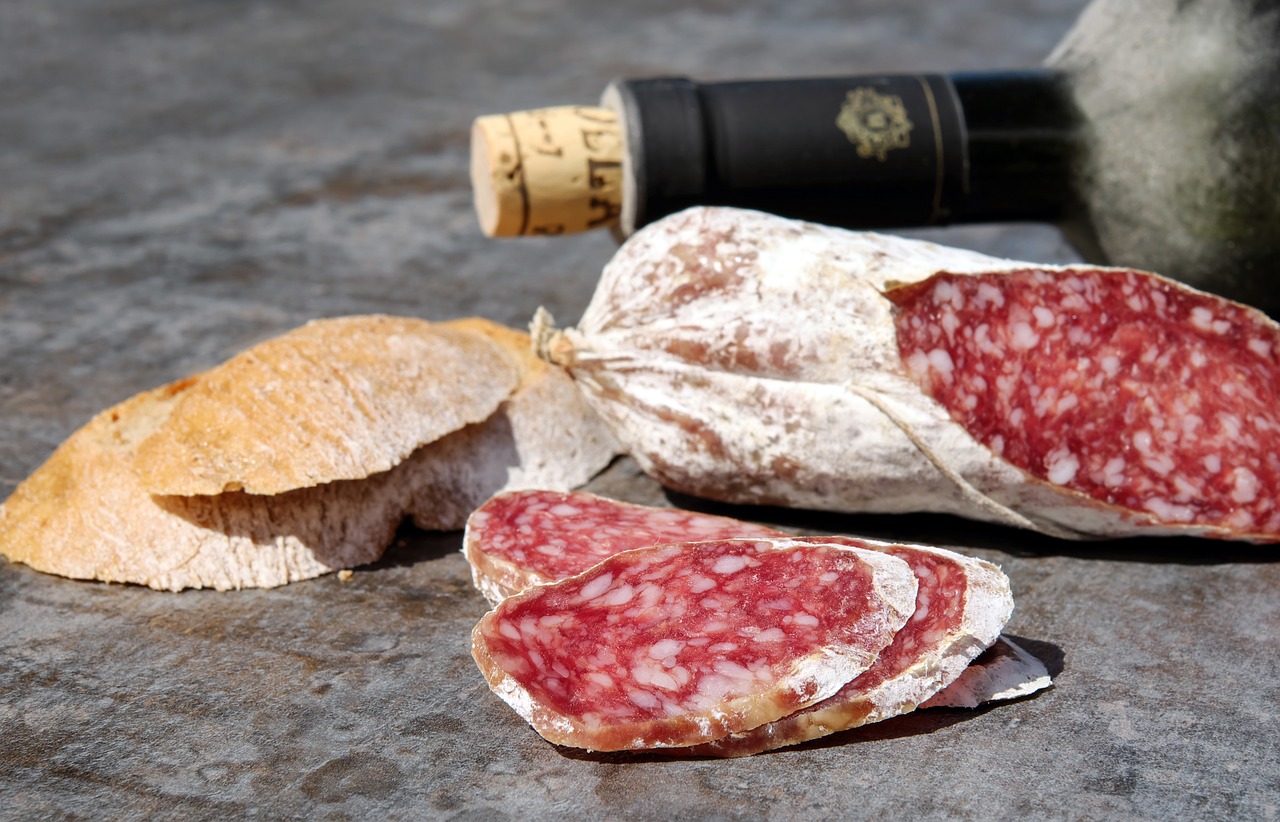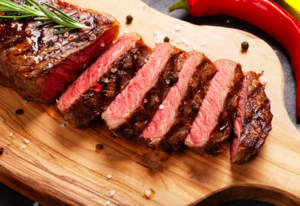Sometimes you may see a pack of sausage that is dry, and the cross-section is full of white dots somewhat like a mosaic. Maybe you have tried this kind of dried sausages, or you have and you just didn’t realise. But do you know how it is made? Where does its special flavor come from? Is it healthy? Can I eat it on a keto diet? Here is the answer sheet of all these questions about salami, an European dried sausage. Let’s dive in!
Table of Contents
What Is Salami?
Salami is a kind of sausage that is cured, fermented and air-dried. It is popular among European countries such as Italy, Hungary, France, and Spain. It is said that the name “salami” originated from an Italian word “salare” which means adding salt.
Salting the meat, generally pork, is a major process of making salami. The makers usually grind the meat coarsely and mix it with other ingredients like salt, sugar, pepper, spices and yeast. Different makers have different traditional recipes, the Italian usually adds garlic and wine while the Hungarian will combine with curry. But salt is certainly included.
What Is Salami Made of?
Salami is typically made of pork, and some are beef and lamb especially in halal and kosher regions due to religious reasons. Sometimes, you may also find venison, wild boar, bison, poultry (mainly turkey and duck), and horse salami. And the northern Italian artisans traditionally use goose meat while makers from the Provence region of France use donkey meat.
In terms of price, beef salami is 50% more expensive than the pork one. And the venison version even costs double that of the pork one. Yet, the most luxurious is the one made of horse meat because horse farms are very rare and it’s nearly impossible to buy on the retail market.
And nowadays, there are some vegetarian salami. For example, salami made from fig which makes the charcuterie board vegetarian-friendly.
► Read More: 20 Pork Cuts Must to Learn (American Cutting Diagram)
How Is Salami Made?

Step 1: Grind and Cure Meat
The producers will firstly grind a certain ratio of lean and fat meat. After that, they will mix the meat with some seasonings such as salt, sugar, pepper, garlic, vinegar etc. And the most important is yeast, otherwise, fermentation cannot be processed.
Step 2: Fermentation
Fermentation is the magic code of making salami which produces the unique flavor and texture of it. Fermenting meat has existed for thousands of years in human history around the world.
It is literally a process of slow acidification that allows beneficial bacteria to grow and preserve the meat. The benign bacteria will produce lactic acid which is actually a byproduct of fermentation. And the lactic acid lowers the pH and coagulates the proteins. It makes pathogenic and toxic bacteria impossible to live in meat in order to keep the meat. This process finally delivers an incredibly tangy flavor that features salami.
After mixing all the ingredients well, the producers will then stuff the mixture into casings with a suitable size. Subsequently, they will hang the raw meat mixture in a warm and humid environment. This will be conducted for 1 to 3 days to let the fermenting bacteria grow.
Step 3: Drying
Next, the makers will transfer the salami to a cool and humid condition. The idea is to dry age it. After one to several months of dry aging, some mold is grown on the exterior of the casing which may seem terrible. But the fact is that the mold helps prevent spoilage, facilitates the drying process, and gives the remarkable flavor. The dried sausages are ready-to-eat and generally sold as a whole or in slices.
Is Salami Healthy? (Nutrition Facts)
There are two sides to every coin. There are both positive and negative impacts for health when eating this kind of sausage.

🙂 Benefits for Health
1. High Protein
Doubtlessly, these dried sausages are rich in protein since they are primarily made of meat. Protein is an essential nutrient to our body which builds and repairs muscles and other body tissues. Moreover, consuming enough protein boosts metabolism and fat burning rate. Plus, it helps reduce the feeling of hunger. As a result, it is a good partner during weight loss.
2. Healthy Bacteria
The major process of producing salami, fermentation, cultivates a great deal of healthy bacteria. These probiotics are beneficial to our digestive systems and restore the balance of good and bad bacteria in the intestine. Taking in an appropriate amount of probiotics can also enhance our immunity.
3. A Range of Minerals
Salami provides small amounts of various minerals. For example, it’s a good source of potassium which assists in maintaining normal blood pressure, water balance, muscle contractions etc. Also, it contains rich zinc that relieves inflammation and boosts the immune system.
4. Rich Vitamin B Complex
Besides that, salami has a rich vitamin B complex particularly B6 and B12. Vitamin B6 can strengthen your immunity while B12 helps the formation of red blood cells. Deficiency in vitamin B can cause serious diseases, and therefore make sure you consume enough daily.
🙁 Drawbacks for Health
1. Too Fat
Since making pork salami uses quite a lot of lard, it has a high fat content. 100g of pork salami contains 41g of fat which is too greasy. Consuming too much fat may cause cardiovascular and cerebrovascular diseases. To avoid the risk, do not overdose, or choose the turkey version.
2. Too Much Sodium
It, just like other kinds of processed meat, is too salty. Taking in an advisable amount of sodium is a must to maintain normal neuronal transmission and muscle contraction.
However, consuming too much sodium can cause high blood pressure. And the bad news is that 100g of traditional salami contains 1890mg of sodium which is too much. Yet, you can pick the low-sodium version to enjoy the same flavor but healthier.
Here is the total nutrients chart per 100g:
| Calories | 440 |
| Total Fat | 41 g |
| Protein | 17 g |
| Carbohydrates | 1.4 g |
| Sodium | 1890 mg |
| Potassium | 253 mg |
In conclusion, salami is beneficial for health in some ways but it contains too much fat and sodium. Therefore, pay attention to the amount of intake, or opt for healthier versions.
Is Salami Keto?
YES! Salami has a rich content of protein and fat but super low in carbohydrates. A typical salami has 1.4g of carbs in every 100g which is extremely low. And this makes it a keto-friendly food. Just rest assured to enjoy it while doing keto.
So…How to Enjoy?
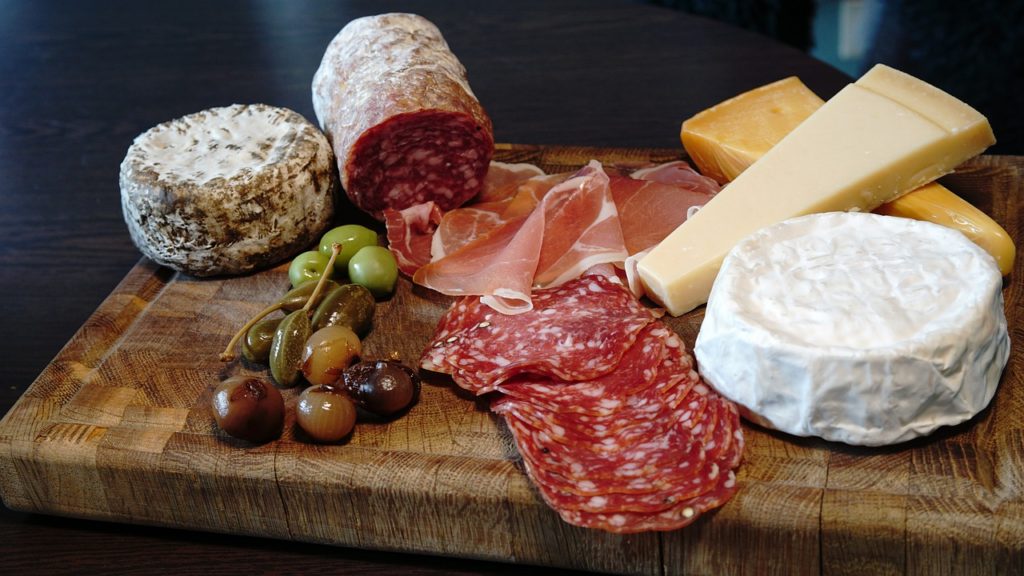
Salami is super versatile and convenient to enjoy. It is ready-to-eat, you can slice (or choose the pre-sliced version) and taste it solely and directly without heating. Alternatively, you can enjoy it with wine, bread and pickled olives as an appetizer. Salami is even suitable for cooking dishes such as pizza, pasta, risotto, salad, sandwich, or anything you think it’s match!
Can Salami Be Frozen? How to Store Salami?
The answer is yes, you can put your salami in a freezer for a few months. To freeze it, cover it with cling wrap and put in an air-tight packaging. To thaw the frozen salami is just transfering to a fridge a day before you use it. However, I don’t recommend storing it in a freezer since the very low temperature may alter the texture.
I suggest keeping it in a fridge instead as the temperature is not that low but low enough to protect it from bacteria. It can be kept for 3 months in the refrigerator with proper packaging.
If the color or smell of the salami is different from its normal state, or it sits at room temperature from the refrigerator for over 2 hours, you should dispose of it.
Famous Types of Salami
The flavor and texture of salami are diverse which varies from many factors such as what animal meat it is made of, lean and fat meat ratio, amount of spices, degree of drying, types of fermenting bacteria, and fermentation environment.
There are thousands of salami produced from European countries every year. They used to name their own salami with the name of origin such as Milano Salami, Toscano Salami, Old Kiev Dry Salami and so on.
The following is a brief introduction of some famous types:
1. Genoa Salami
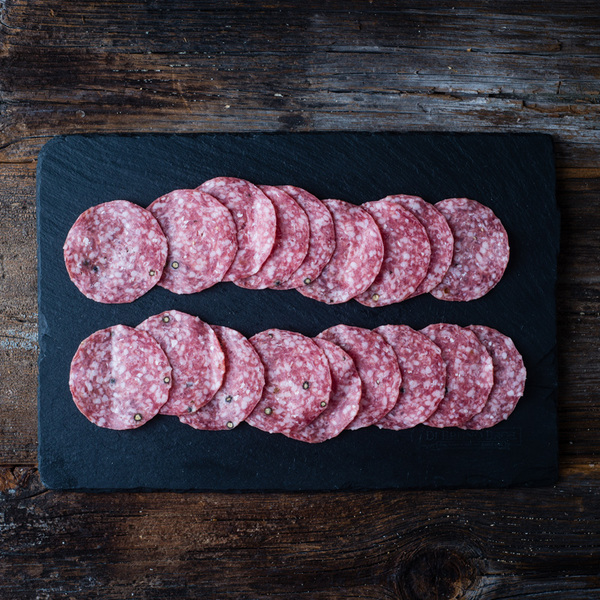
The name of Genoa Salami comes from its commonly believed origin, Genoa, an Italian city. The pigs from this great city are traditionally raised in Mediterranean woodlands with foods like acorns, hazelnuts, and chestnuts which leads to the high quality of pork. Genoa cuisine always includes pork but not beef because there are no plains in the city to grow cattle. Therefore, the Genoa is typically made of pork.
Seasoning the Genoa needs salt, pepper, garlic, white and black peppercorns, and red or white wine. It is nice to enjoy it as part of an antipasto platter or simply add it in a sandwich.
2. Milano Salami
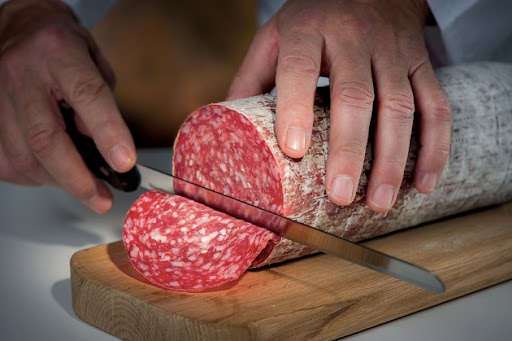
Obviously, it comes from Milan which is probably the most popular salami in Italy. Milano Salami is featured with a light ruby red color and the evenly distributed white lard grains. This is quite similar to Hungarian Salami but that tastes more sweet.
The seasonings of the Milano include salt, garlic, ground white pepper, and black peppercorns while the Hungarian version involves sugar. Milano is fantastic with cheeses, in salad, or on pizza.
3. Toscano / Tuscan Salami

Toscano (or Tuscan) Salami has a rich and strong flavor as the mixture of lean and lard is seasoned with fresh garlic and black pepper as well as other ingredients. The dry aging process further enhances the flavor and scent. It is best to serve the Toscano in slices with cheese and meat.
4. Finocchiona Salami
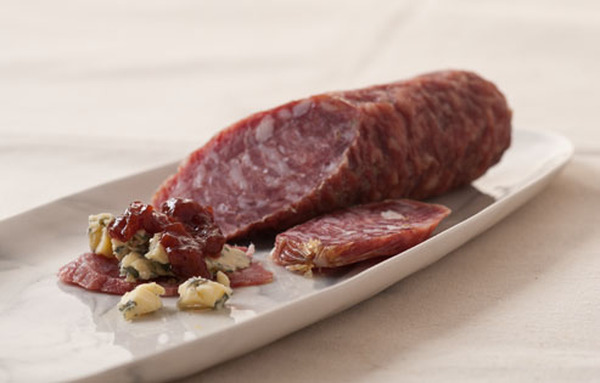
Finocchiona Salami is classic in Tuscan-style and named after the herb that delivers its featured flavor—fennel or ‘finocchio’. It is coarser than the regular salami and mixed with fennel seeds, sea salt and black pepper which make it a bit spicy. The drying duration of the Finocchiona ranges from 3 months to an entire year to intensify the flavor.
The chefs love to add it into soups and stew thanks to its fennel aroma. Or throw it on pizzas and nachos as toppings.
5. Coppa / Capocollo / Capicola Salami

This ham-like salami is easy to recognize by its beautiful marbling. Capicola is the term in North America while the Italian call it Coppa or Capocollo.
It is made of the whole muscle running from the pig’s neck to the fourth or fifth rib of the shoulder. The meat is not ground like the regular types. Therefore, the lovely marbling is kept, and it has an irregular shape. This is to say, the Capicola is not as perfectly round as the ground one in which the meat is inserted into a casing. The chef usually slice the Capicola thin and serve with cheese, or use it for salads.
6. Pepperoni

Pepperoni is not a traditional Italian sausage. It was invented by Italian Americans and is very popular in American pizza. It is finely ground, slightly smoked, and seasoned with pepper and spices, so it tastes a little bit spicy.
7. Others
There are actually thousands of types of salami. Apart from the different traditional recipes and animal meat being used, the producers also tried to invent new styles by adding various ingredients. For example, there are black truffle salami, white truffle salami, parmesano salami, and paprika salami. Don’t know how to choose from tons of salami? Order a salami sampler for the first try!
If you buy on GourmetFoodStore.com, use our unique discount code: KitchenTeller on the Basket page or the Payment page during checkout to enjoy 10% OFF!
If you buy on Di Bruno Bros, click HERE to check the latest discount!
Salami vs Salumi: Is It a Typo?
Sometimes you may see the word “salumi” on the menu when dining out. Is it a typo? Actually, salami is a kind of salumi.
The word Salumi comes from an Italian word “salume” while the prefix “sal” was taken from Latin meaning “salt”. And salumi means “salted meat”; therefore salami as a variety of cured sausage, it can be also classified as a salumi. Ham, pancetta (Italian bacon) and capocollo are kinds of salumi as well.
► Read More: 8 Types of Ham You Must Try! | Shopping Tips for Newbies in Ham
Summary
After reading this guide, you now know more about salami from the process to its health impacts. The artisanship of making this kind of old sausage is bravo, especially the fermentation process delivers a distinctive flavor. It is suitable even for the people who are doing keto. But do not eat too much at once since it contains quite a lot of fat and sodium. There are millions of types of salami that possess different features. Do try some of them according to your own preferences, you will get a jackpot one day!
► Read More: What & How Cheese Is Made? | Cheese Beginner’s Guide
► Read More: 20+ Types of Cheese Must To Know | The Most Complete Cheese Guide

